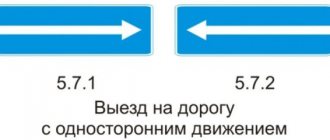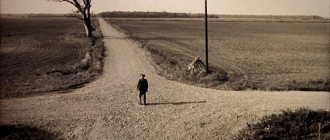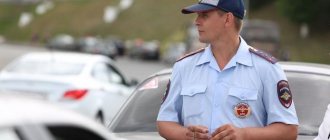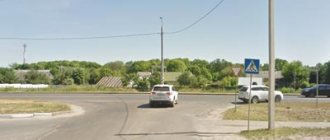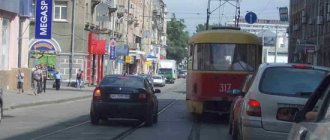Good afternoon, dear reader.
This article discusses the rules for pedestrians regulating the issues of crossing the roadway. You will learn how to cross the road correctly and what you need to pay attention to when doing so.
Let me remind you that in the previous article we talked about choosing the right place to cross the roadway. However, choosing a location is only half the battle. The other half is the correct behavior of a pedestrian when crossing the road. After all, correct behavior is the key to pedestrian safety.
Signalized intersection and signalized crossing
Let's turn to clause 4.4 of the traffic rules:
4.4. In places where traffic is regulated, pedestrians must be guided by the signals of a traffic controller or a pedestrian traffic light, and in its absence, a transport traffic light.
A pedestrian crossing or intersection is controlled only if the traffic is regulated by a traffic controller (police officer) or a working traffic light.
Please note that if the yellow signal is constantly flashing at the traffic light, then such an intersection is uncontrolled.
Traffic controller signals for pedestrians
The traffic controller automatically turns any intersection into a regulated one. If there is a traffic controller at the intersection, then you need to be guided by his gestures, and not by the traffic lights!
The rules provide for 3 possible traffic controller gestures:
| Gesture | Pedestrian implications |
| right hand raised above head | No Pedestrians |
| right arm extended forward | Pedestrian movement is permitted from behind the traffic controller |
| arms extended in different directions in the shape of the letter T | Pedestrian movement is permitted from the chest and from the back of the traffic controller |
Let's look at a few examples.
In the figure, the right hand of the traffic controller is extended forward, therefore pedestrians can only cross the road from the side of the policeman’s back.
Please note that this gesture allows the red car to turn right, i.e. the trajectories of the pedestrian and the car intersect. In this case, the car must give way (clause 13.1 of the Rules). However, the pedestrian should be careful, because... the driver may not know the rules or simply not notice the pedestrian.
In the figure, the traffic controller’s arms are extended to the sides, i.e. Pedestrians are allowed to move from both the chest and the back.
At the same time, both orange and blue cars have the right to turn right, giving way to pedestrians. So be careful.
Since many pedestrians do not know the traffic controller’s gestures, police officers in practice can use additional gestures. For example, they allow pedestrians to move by simply waving their hand in the right direction.
At what traffic light can you cross the road?
A traffic light at an intersection makes the intersection controllable only if it operates in the red-amber-green mode (and not in the flashing yellow signal mode).
A special pedestrian traffic light , on which there are images of little men, allows the movement of pedestrians if the traffic light is green, and prohibits it if the traffic light is red. Crossing a red light is a violation of traffic rules, for which a pedestrian may be subject to an administrative fine.
If at an intersection there is only a car traffic light and no pedestrian traffic light, then you need to be guided by the signals of the car traffic light. But how to be guided is not specified in the rules.
Therefore, everything is left to the discretion of the pedestrian. Some pedestrians cross the road when the signal in the right direction is green, while others cross when the signal for all cars is red. In general, the situation is controversial, so be careful. Fortunately, there are fewer and fewer such intersections over time.
Unregulated pedestrian crossing
Clause 4.5 of the traffic rules:
4.5. At unregulated pedestrian crossings, pedestrians can enter the roadway (tram tracks) after assessing the distance to approaching vehicles, their speed and making sure that the crossing will be safe for them. When crossing the road outside a pedestrian crossing, pedestrians, in addition, must not interfere with the movement of vehicles and exit from behind a standing vehicle or other obstacle that limits visibility without making sure that there are no approaching vehicles.
At unregulated crossings, the rules for pedestrians are strict but fair - you should your own traffic safety
Please note that you should not throw yourself directly under the wheels of oncoming vehicles, as many pedestrians do.
How to cross the road if there is no crossing?
When crossing the road outside the crossing, you need to be even more attentive to the issue of safety. At the same time, you cannot go out onto the roadway because of parked cars. It is also prohibited to interfere with the movement of vehicles, i.e. Outside a pedestrian crossing, you should cross the road at a considerable distance from approaching vehicles.
In most cases, when an accident occurs with a pedestrian outside a pedestrian crossing, the pedestrian is at fault. Those. In addition to the fact that the pedestrian may suffer physically, he will also suffer financially, because the culprit of the accident pays for the repair of the damaged vehicle and other damage.
Crossing the roadway in the absence of a pedestrian crossing
There may be no pedestrian path.
Under such circumstances, it is permissible to cross the road in the area of the intersection. Crossing diagonally is prohibited by traffic regulations. At the intersection, drivers should drive at low speed. Therefore, you need to make sure in advance that drivers give way and that the red light is on for them. It also happens that there are no intersections or pedestrian roads at all. Then the pedestrian can cross the road in those areas where you can see vehicles at a decent distance from you, and calculate the speed of the vehicle and the time it takes to cross the road. And also there should not be any fences, bumpers, dividing lines, etc. on the road.
How to cross the road correctly?
Clause 4.6 of the rules regulates behavior when crossing the road:
4.6. Once on the roadway (tram tracks), pedestrians should not linger or stop unless this is related to ensuring traffic safety. Pedestrians who do not have time to complete the crossing must stop on the line dividing traffic flows in opposite directions. You can continue crossing only after making sure that further movement is safe and taking into account the traffic light signal (traffic controller).
Traffic regulations prohibit a pedestrian from stopping on the roadway, except in cases where this is related to ensuring traffic safety.
For example, if you start walking along a crossing, but notice a car moving at high speed in the next lane, you can stop.
However, I highly recommend stopping on the roadway unnecessarily, because... the driver may not be ready for such a “maneuver” and allow a collision.
The rules allow stopping on the line dividing traffic flows in opposite directions. However, this should be avoided on busy roads. It is better to calculate your own strength in advance, choose a convenient moment and cover the entire width of the roadway in one go.
I will also note that the line dividing traffic flows in opposite directions is some imaginary line that you are asked to determine yourself.
What color should you cross the road with?
Nowadays there are traffic lights for pedestrians almost everywhere. And when I was in first grade, they had never even heard of such a miracle.
And then an inspector comes to our school. Open lesson, everything is planned. The inspector asks the question: “What color of traffic light should you cross the road at?”
I furiously reach out my hand, the teacher gives me the floor.
— A pedestrian must cross the road at a red light!
It’s worth clarifying a little here: very often I traveled with my father by car, and I always noticed that as soon as the red light turned on, the cars slowed down, and then stopped and pedestrians calmly crossed the road. Therefore, I did not have the slightest doubt about my answer.
Even now, when crossing the road, I look at the traffic light of the exact lane I am about to cross. The internal timer always tells you how long the red light will remain on and how much time is left to cross the lane.
Naturally, the classmates laughed, the teacher blushed, and the inspector gave a boring lecture about the importance of crossing the road when the light is green. They never convinced me, then I realized that adults make mistakes too
They never convinced me, then I realized that adults make mistakes too.
What must a pedestrian do before crossing the roadway?
Before crossing the roadway, a pedestrian must stop at the edge of the sidewalk (without stepping on the curb). A stop is needed to inspect the roadway and make sure there is no approaching traffic (from the left and right).
Is it possible to start crossing the roadway when the traffic light is flashing green?
This is not possible, since you may not have time to cross the roadway before the yellow traffic light turns on, which already prohibits movement. In this situation, the requirement of the Rules (clause 4.6) regarding traffic safety taking into account the traffic light signal is of paramount importance.
How can you tell when a car is about to make a turn?
When making a turn, the driver must turn on the turn signal in advance, which we see as flashing lights on the left or right side of the car. But before starting to move, the pedestrian must make sure (if the driver has started performing the maneuver) that the transition will be safe.
Why is it dangerous for children to cross the road holding hands?
Because in a dangerous situation, each person reacts differently. Pedestrians can pull each other's arms in different directions and begin to rush along the roadway, which in turn, as a rule, leads to an accident.
Why is an intersection considered one of the most dangerous places on the road?
At the intersection, the paths of pedestrians and vehicles intersect, which can move straight, turn and turn in the opposite direction.
How to cross the road if there is no marked pedestrian crossing at the intersection?
You can cross the roadway along the sidewalk line, observing the rules for crossing an unregulated pedestrian crossing and carefully watching for turning cars.
What should pedestrians do when a traffic controller raises his hand?
Pedestrians should not enter the roadway to cross the road, and those caught by this signal on the roadway must vacate it, and if this is not possible, stop on the line dividing traffic flows in opposite directions. But it should be remembered that it is dangerous to be here: vehicles are moving in front of the pedestrian and behind him.
What is the meaning of flashing signals - green and yellow?
-The green flashing signal allows movement and informs that its time is expiring and the prohibiting signal will soon be turned on
-A yellow flashing signal allows movement and informs about the presence of an unregulated intersection or pedestrian crossing, warning of danger.
What does a traffic controller's signal mean for a pedestrian when his right arm is extended forward?
Pedestrians are allowed to cross the roadway only behind the traffic controller. Movement from the left, right side and chest is prohibited.
Good afternoon, dear reader.
This article discusses the rules for pedestrians regulating the issues of crossing the roadway
You will learn how to cross the road correctly and what you need to pay attention to when doing so.
Let me remind you that in the previous article we talked about choosing the right place to cross the roadway. However, choosing a location is only half the battle. The other half is the correct behavior of a pedestrian when crossing the road. After all, correct behavior is the key to pedestrian safety.
When is it prohibited to go out onto the roadway?
Paragraph 4.7 of the traffic rules:
4.7. When approaching vehicles with a blue flashing light (blue and red) and a special sound signal on, pedestrians are required to refrain from crossing the road, and pedestrians on the roadway (tram tracks) must immediately vacate the roadway (tram tracks).
The rules prohibit entering the road in front of special service vehicles that have both flashing lights and sound signals on:
Please note that if a pedestrian has the right of way (walking along the crossing), then he must give way only to a car with the sound signal on .
If the driver turns on the flashing lights, but does not turn on the siren, then pedestrians are not obliged to give way to him. However, you shouldn’t deliberately throw yourself under the wheels. A pedestrian on the road risks life and health, so it is better to let the offender’s car pass once again than to end up in the hospital.
In practice, I recommend not throwing yourself under the wheels not only of cars with special signals, but also of all other cars. Unfortunately, a pedestrian’s chances of surviving an accident with a car traveling at a speed of 50–60 km/h are slim.
Fines for pedestrians at crossings
Fines for pedestrians are given in Articles 12.29 and 12.30 of the Code of Administrative Offenses:
| Violation | Punishment |
| Violation of rules by a pedestrian | warning or 500 rubles |
| Violation of rules resulting in obstruction of traffic or harm to health | 1,000 rubles |
Thus, both for crossing a red light and for jaywalking, a pedestrian can be punished with only a small fine.
Well, the next article discusses the rules for waiting for route vehicles.
Good luck on the roads!
Responsibility of pedestrians for traffic violations
Pedestrians are often personally responsible for an incident that occurs while crossing the roadway. The actions of a pedestrian are not always recognized as lawful. For this reason, increased care and responsibility on the roads can save your personal budget, and most importantly, life and health.
Liability in the form of an administrative fine or warning is imposed if unlawful actions:
- did not cause damage to health or create obstacles to traffic flow;
- disrupted normal traffic flow;
- led to minor harm to the victim's health.
Civil liability means that the culprit must compensate for the damage caused to the property, health, and moral condition of the victim.
Criminal liability arises if unlawful actions lead to the following consequences:
- Serious damage to health. The culprit may be limited in freedom (3 years or less), forced to perform forced labor (2 years or less), arrested (4 months or less), imprisoned (2 years or less).
- Death of the victim. In this situation, the freedom of the culprit may be limited (4 years or less), forced labor (4 years or less), or imprisonment (4 years or less).
The death of two or more persons is also included in this list. This case implies forced labor (5 years or less) or imprisonment (7 years or less).

